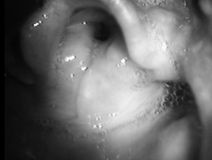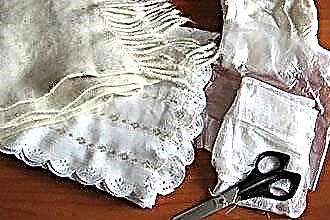Hearing test in newborns is a way to identify pathologies in the development of the auditory analyzer. Audiometric tests allow assessing the quality of perception of sound signals by the sound-conducting and sound-perceiving system of the hearing organ in infants. Early diagnosis of pathologies in the development of the newborn increases the chances of eliminating hearing problems and restoring the normal threshold sensitivity of the auditory receptors.
Audiometry is one of the most reliable ways to measure hearing dysfunction at an early age. Based on the test results, the audiologist can determine in which part of the auditory analyzer pathological changes have occurred. Accurate diagnosis influences the choice of treatment regimen and the likelihood of achieving the desired therapeutic results.
The purpose of audiometry

The first hearing test in newborns in the maternity hospital allows you to determine the presence of congenital abnormalities in the child. Late detection and treatment of auditory dysfunction is fraught with the development of persistent hearing loss and delays in speech development. In medical practice, there are cases when children were diagnosed with "dementia" only because of the development of auditory dysfunction. Medical errors in most cases were associated with late diagnosis of hearing loss, which influenced the characteristics of the child's development.
To prevent complete hearing loss and determine the type of pathology in time, experts recommend conducting audiometric studies with newborns in the first months of life. In addition, pediatricians recommend from time to time to test hearing acuity at home, using specially developed techniques that do not require special equipment.
First check
According to statistics, ear pathologies are diagnosed in about 3-4 newborns out of 1000 born. Untimely elimination of violations in the auditory analyzer leads to the development of persistent hearing loss and complete deafness. Hearing dysfunction in infants can occur even before birth (prenatally), during passage through the birth canal (perinally), or after birth (postnatally).
Primary audiometry is performed in the maternity hospital 4-7 days after the birth of the child. Ear screening is a standardized procedure that can objectively assess hearing acuity and identify children with audiological impairments. How is hearing tested in a newborn in a maternity hospital?
 During the screening, the specialist does the following:
During the screening, the specialist does the following:
- a tip from an audiological device is inserted into the ear of a sleeping child;
- an audiometer creates a sound signal that enters the outer ear of the newborn through a tube;
- the device registers the acuity of hearing according to the data obtained from the electrodes registering bursts of activity in certain areas of the brain when processing sound signals.
Important! Nasal congestion should not be screened as this may affect test results.
Indications
In the absence of pathologies at an early stage of the child's development, audiometry should be performed at least 1 time in several months. Congenital hearing loss due to a genetic predisposition may not appear immediately, but much later. Failure to detect auditory dysfunction can lead to irreversible partial or complete hearing loss.
Before checking the hearing in a baby, the following indications for the procedure should be taken into account:
- the development of hydrocephalus;
- prematurity;
- development of purulent otitis media;
- birth trauma to the head;
- transfer of jaundice after birth;
- the presence of sensorineural hearing loss in parents;
- upper respiratory tract infection.
The presence of some of the above pathologies are direct indications for an audiometric examination in a child at least once every 6 months.
Important! If a child aged 3 months and older does not respond to loud sounds, this may indicate the development of ear pathology.
Reflex Moro
 The Moro reflex is one of the easiest ways to measure hearing sensitivity in newborns. The test does not give an idea of the threshold of hearing and the sensitivity of the auditory receptors, however, it excludes the likelihood of developing grade 3 and 4 hearing loss. How to test hearing in a newborn?
The Moro reflex is one of the easiest ways to measure hearing sensitivity in newborns. The test does not give an idea of the threshold of hearing and the sensitivity of the auditory receptors, however, it excludes the likelihood of developing grade 3 and 4 hearing loss. How to test hearing in a newborn?
- lay the newborn on a flat surface;
- straighten the legs and arms of the child;
- at a distance of 20 cm from one ear, clap your hands sharply;
- check the receptivity of the second ear in the same way.
When a harsh sound is perceived, the child usually spreads his fingers, waving his arms, or crying. Such a reaction signals fear and the body's attempt to defend itself against a possible threat. Failure to respond to claps near the head indicates auditory dysfunction. It can be caused by pathologies in the sound-conducting (middle and outer ear) or sound-receiving (inner ear, auditory nerve, receptors) system of the auditory analyzer.
Methodology I. V. Kalmykova
To determine the degree of sensitivity of the auditory analyzer, you will need several items that create sound signals of different intensities. As sound sources, you can use plastic cans filled with 1/3 of cereals. According to the method of I.V. Kalmykova, it is more advisable to use cans with fillers such as:
- semolina;
- buckwheat;
- peas.
A can of semolina creates the quietest sound in terms of intensity, with buckwheat - louder, and with peas - the loudest.
How to test a newborn's hearing at home? To conduct a simple audiometric examination, you need to do the following:
- one person should distract the newborn's attention to himself, holding a bright toy in his hands;
- the second person, at a distance of 10 cm from the child's auricle, creates sound signals using cans with various fillers;
- auditory sensitivity is tested for the right and left ear;
- it is desirable to create sound signals with an interval of 30-40 seconds.
 During the test, it is desirable to provide an increasing intensity of the audio signals. First, use a jar of semolina, then - with buckwheat, and last of all - with peas. Otherwise, the child will only react to the first high-intensity sound.
During the test, it is desirable to provide an increasing intensity of the audio signals. First, use a jar of semolina, then - with buckwheat, and last of all - with peas. Otherwise, the child will only react to the first high-intensity sound.
According to pediatricians, children under the age of 6 months only respond to sounds with an intensity of at least 60-70 dB. Older children should react equally to noises with an intensity of 20 dB or more.
If there is no normal reaction, the test should be repeated after a couple of days.
If the test results are unsatisfactory, it is better to be examined by an otolaryngologist.



